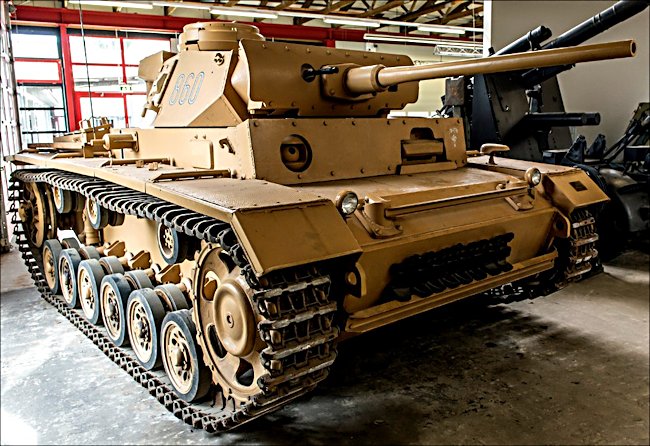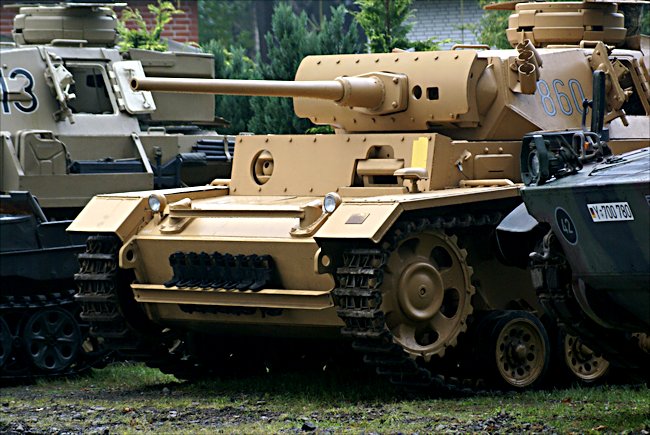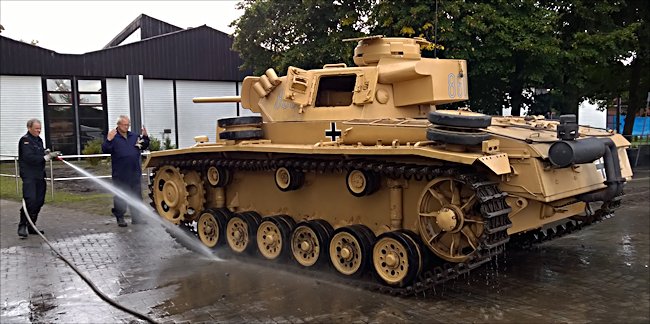The Panzer III Ausf. M
This German Panzer III Tank Ausf. M can be found at the German Tank Museum - Deutsches Panzermuseum in Munster, Germany.

German Panzer III Ausf. M tank in Afrika Korps desert colours with a long 50mm gun and extra armour on the upper hull.
At the beginning of the war the German army had completely taken on board the blitzkrieg lightning war tactic. This involves self-contained Panzer divisions making penetrating attacks into enemy territory and relying on its own resources. In 1935. The structure of a Panzer division was laid down.
It was to include 15,000 men and a Panzer brigade of 560 tanks. They will be supported by two motorised infantry battalion (the Panzer Grenadier's), one of them in armoured half tracks. An armoured reconnaissance section. An anti-tank field gun Battalion, and and artillery battalion. Each Panzer division would have its own logistics and supply section.
Hard-hitting fast moving spearheads of tanks and mobile infantry supported by artillery was what the Germans believed would win the next war. The addition of air support by bombers and Stuka dive bombers would make the German army formidable opponent.

German Panzer III Ausf. M tank with the reinforced gun mantel armour
The heavy tanks like the Panzer III and IV would be used to punch a hole through the enemy's lines of defence. Light tanks like the Panzer 38(t) and Panzer II would be used on the flanks, to protect the main battle tanks from infantry and anti-tank gun attacks. The Panzer III was relied upon to smash a gap into which the rest of the Panzer division could follow.
A lot of thought had gone into the structure of the Panzer division. As a result it was a well-balanced force that could call on the support of any or all of its component parts in times of danger or when and objective had to be captured.
The purpose of the Panzer division was to launch a speedy advance deep into enemy territory and keep going, spreading confusion, fear and panic in the enemy command and communications systems. This they did very well in May 1940 when the Germans attacked France by going through the Belgium Ardennes.

German Panzer III Ausf. M tank carwash at the Deutsches Panzermuseum in Munster, Germany
One of the secrets of the Panzer division success was that they had a Luftwaffe staff officer ride with the attack columns in a command vehicle that had radio access to the control rooms. When it was necessary, he could request ground attack missions to assist the Panzer III tanks at the front of the battlefield. The French and British did not have this level of support from the air forces.
The training given to the crews of the Panzer III tank emphasised speed and independence of thought. Crews did not have to wait for a change in orders to deviate from the mission if they can see a way around the problem to achieve the objective. This was not encouraged in the Allied army.
The Panzer III tank had a five-man crew, commander, driver, gunner, loader spare driver/machine gunner. It was used as the main battle tank. In 1940 it had a 37 mm gun and only 30 mm frontal armour. It had three machine guns, two either side of the main gun and one in the hull opposite the driver's position. It had a top speed of around 25 mph.
The German army soon found out that the 37 mm short barrelled cannon did not have enough penetrating power to knock out some of the heavier Allied tanks. Later 50 mm cannons were fitted to Panzer III Ausf. G tanks, but this was not in time for the battle of France.
The Panzer IV tank, with its short barrelled low velocity 75 mm gun was used as an infantry support tank during 1940. It was designed to fire high explosive shells and lacked the armour piercing capabilities to take on heavy tanks in a tank on tank battle. Once the Panzer IV was upgraded with a high velocity long barrelled 75 mm cannon, it became the main battle tank of the German army during the rest of World War II.
WW2 tank books

